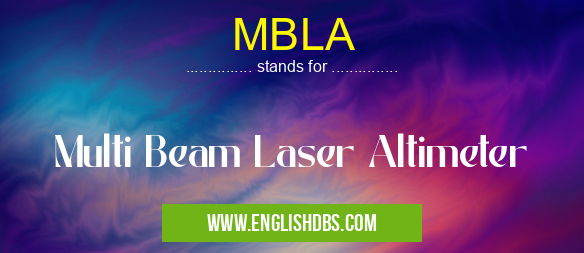What does MBLA mean in UNCLASSIFIED
MBLA stands for Multi Beam Laser Altimeter. It is a remote sensing instrument that uses multiple laser beams to measure the height of objects on the ground. The data collected by an MBLA can be used to create detailed maps of the terrain, identify obstacles, and plan construction projects.

MBLA meaning in Unclassified in Miscellaneous
MBLA mostly used in an acronym Unclassified in Category Miscellaneous that means Multi Beam Laser Altimeter
Shorthand: MBLA,
Full Form: Multi Beam Laser Altimeter
For more information of "Multi Beam Laser Altimeter", see the section below.
How Does an MBLA Work?
An MBLA emits multiple laser beams towards the ground. The beams are reflected off the surface and back to the instrument. The time it takes for each beam to travel to and from the ground is measured, and this information is used to calculate the height of the surface.
The number of beams emitted by an MBLA can vary from a few to several hundred. The more beams that are used, the more detailed the map that can be created.
Applications of MBLA
MBLA is used in a variety of applications, including:
- Mapping: MBLA can be used to create detailed maps of the terrain. This information can be used for planning construction projects, land use planning, and environmental monitoring.
- Obstacle detection: MBLA can be used to identify obstacles on the ground, such as trees, buildings, and power lines. This information can be used for navigation, collision avoidance, and safety planning.
- Construction planning: MBLA can be used to plan construction projects by providing detailed information about the terrain. This information can be used to determine the best location for buildings, roads, and other infrastructure.
Conclusion
MBLA is a powerful tool that can be used to collect detailed information about the ground. This information can be used for a variety of applications, including mapping, obstacle detection, and construction planning.
Essential Questions and Answers on Multi Beam Laser Altimeter in "MISCELLANEOUS»UNFILED"
What is a Multi Beam Laser Altimeter (MBLA)?
A Multi Beam Laser Altimeter (MBLA) is an advanced remote sensing technology that utilizes multiple laser beams to measure the topography and elevation of a surface. It operates on the principle of laser ranging, where laser pulses are emitted towards the surface, and the time taken for the reflected pulses to return is recorded. This data is then processed to generate a highly accurate and detailed representation of the surface being measured.
What are the advantages of using a MBLA over traditional altimeters?
MBLA offers several advantages over traditional altimeters, including:
- Higher Accuracy: MBLA utilizes multiple laser beams, allowing for more precise measurements and reduced errors.
- Wider Coverage: MBLA systems can emit laser beams in multiple directions, providing a wider coverage area compared to single-beam altimeters.
- Enhanced Resolution: The use of multiple laser beams enables the generation of detailed elevation maps with higher resolution.
- Reduced Noise: MBLA systems are less susceptible to noise and interference, resulting in cleaner and more accurate data.
What are the applications of MBLA?
MBLA technology has a wide range of applications, including:
- Topography Mapping: Generating high-resolution elevation maps for various purposes, such as land surveying, urban planning, and environmental modeling.
- Bathymetry: Measuring the depth and topography of water bodies, including oceans, rivers, and lakes.
- Forest Canopy Profiling: Estimating the height and structure of vegetation, aiding in forest management and carbon sequestration studies.
- Glacier Monitoring: Tracking the elevation changes and dynamics of glaciers to understand climate change impacts.
- Archaeology: Discovering and mapping buried structures and archaeological features.
What are the limitations of MBLA?
While MBLA is a powerful technology, it has certain limitations:
- Atmospheric Effects: Laser beams can be affected by atmospheric conditions, such as clouds, fog, and dust, which can impact the accuracy of measurements.
- Surface Characteristics: Certain surface characteristics, such as highly reflective or rough surfaces, may hinder the accurate detection of laser pulses.
- Data Processing: The vast amount of data generated by MBLA systems requires specialized processing algorithms and software for efficient analysis.
What is the future of MBLA technology?
MBLA technology is continuously evolving, with ongoing research and advancements focused on:
- Improved Accuracy: Developing new algorithms and techniques to further enhance the precision of elevation measurements.
- Increased Coverage: Exploring new methods to expand the coverage area and reduce data gaps.
- Multispectral Capabilities: Integrating additional sensors to collect data in multiple wavelengths, providing more comprehensive information about the surface being measured.
- Integration with Other Technologies: Combining MBLA with other remote sensing systems, such as lidar and hyperspectral imaging, for more comprehensive data acquisition and analysis.
